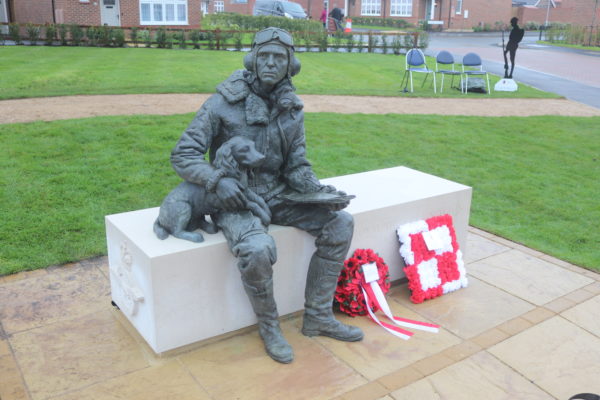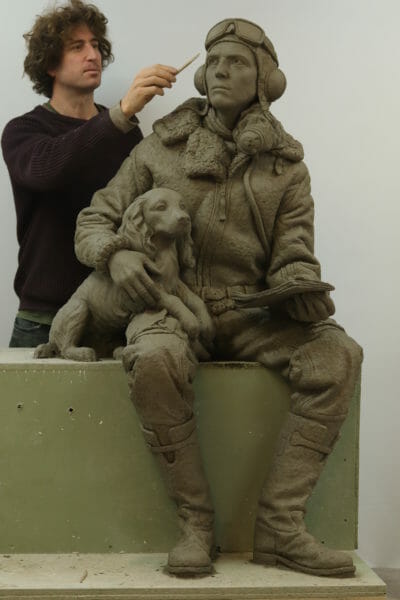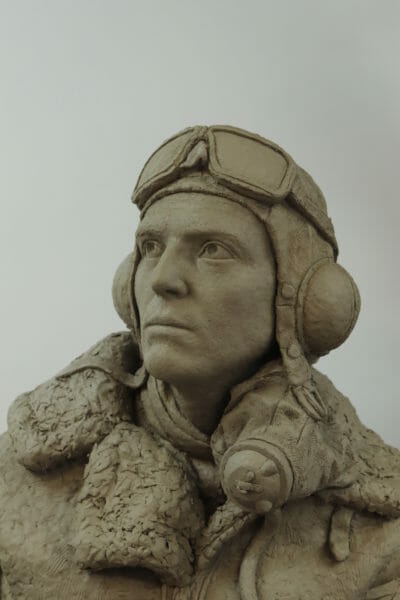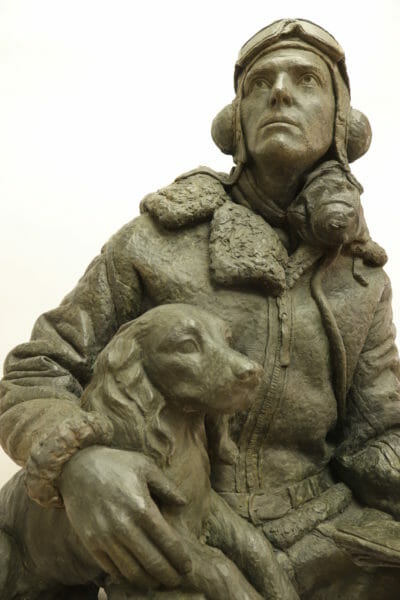World War II Pilot statue with Spaniel

RAF Newton, a significant Royal Air Force station in Nottinghamshire was used as a bomber base and then as a flying training school from World War II through to the late 2000s. In 1940 Newton was under the control of No.1 Group bomber command who saw it’s 103 and 150 Squadrons making several night bombing raids on the continent.
During its service in WWII RAF Newton took on the significant role of being home to No 16 (Polish) Flying training school where it provided training for Polish Airmen serving in the RAF
By the late 2000s the Airbase was disused and was ear marked for various redevelopments. The winning pitch was made by Redrow housing who were granted planning permission to build 500 new houses on the site.
In May 2011, The RAF Newton Fund was set up by local residents and veterans who came together over the previous year to ensure that a permanent structure was created before the historic base disappeared forever and also to remember all those who served there between 1940 and 2001.
The artist and writer Tim O’brien won the public vote with his concept of a seated wartime pilot with his pet Spaniel on a bench. Tom Nicholls’ then interpreted the design into a sculptural piece.

Tom’s first task was to decide which would be the most suitable materials for the work. Due to the piece being installed at ground level and having a certain interactive element (functioning bench) we decided that a bronze figure would be suitable as elements of the design were too thin and fragile to be carved in stone.
The second task was to establish exactly which era of Pilot we felt would be most appropriate to represent such a long stretch of history. We wanted to ensure that the clothing was coherent, era correct and sculpturally pleasing whilst also being very recognisably from the most iconic era to the layman. We decided that the Wellington Bomber era was most iconic and also provided lots of different textures of clothing and equipment which were perfect for creating sculptural interest and detailing.
To aid with the task of sourcing a historically correct outfit we contacted a specialist in military clothing at the RAF museum in Hendon. The Museum was incredibly knowledgeable and helpful and agreed to loan us a genuine 1940 Wellington Bomber era outift with Gas mask, flying helmet and boots. Interestingly we were loaned the exact same sheepskin lined bomber trousers as were used for reference by Philip Jackson on the Bomber Command memorial in Hyde Park…the clue is the exact same crease appearing on the pockets of the trousers on both statues!
A life model was carefully selected. We wanted a strong, slightly classical looking man to pose. The pose was chosen with the model looking slightly up to the sky with a thoughtful, slightly pensive expression. This is in reference to the RAF motto ‘Per Adua Ad Astra’ which means ‘Through adversity to the stars’.
The piece was then modelled up in clay by observation from the life model. The outfit was set up on a static prop so that every fold, texture and detail could be fully observed. The quality of materials and worksmanship that went into the clothing is really awe inspiring and something we felt compelled to capture in the clay as much as possible. The quality of that clothing really seemed to me to embody the collective effort and spirit of all those involved in such a difficult time.

Dog
A spaniel was chosen partly as a nod to the many RAF Newton pilots who owned dogs over it’s 60 year history and also to the RAF police sniffer dogs (which were spaniels). A Labrador was considered but was dismissed by the public ballot in 2014 because it was deemed that the public would automatically assume the pilot was Guy Gibson, who has no association with this airfield. Finding reference to work from to create the Spaniel in the required pose was a challenge. Tom managed to track down a suitable London based dog by putting out a request on Facebook. The dog (Lyra) was then kindly bought to our workshop for a photo session. A naturally very lively breed of dog so it was very difficult to keep the dog still but eventually, with the aid of snacks and a number of hours we got enough good pics to work from.

Casting
The bronze casting process was taken on by Bronze age Foundry who did an excellent job! There are a vast array of finishes and patinas to choose from but we decided to go for a classic dark green colour to suite the historical military context and to provide a contrast to the Portland limestone base.
Unveiling
The Statue was well received and it was humbling to see how much it meant to the local community and the Veterans who attended the unveiling ceremony. The RAF put on an impressive ceremony in the presence of Air Chief Marshal Sir Andrew Pulford. The unveiling was covered by BBC East midlands news footage and on the Forces Network…see links for more info:
Wellington bomber pilot statue unveiled at former RAF Newton site (forces.net) and redrow housing article Grand parade unveils statue dedicated to those who served at the former Nottingham RAF base | Redrow